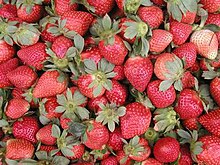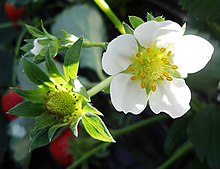Uploaded on Jan 2, 2011
http://www.BigelowBrook.com/donate
This is an instructional video on how to build your own growing tower for use in aquaponic or hydroponic systems.
This is an instructional video on how to build your own growing tower for use in aquaponic or hydroponic systems.
Details about Expanded Shale
growing media can be found at http://www.ExpandedShale.com . For more info, see my blog at http://web4deb.blogspot.com or http://www.BigelowBrook.com Also "like" us on Facebook at http://www.Facebook.com/BigelowBrook
It is cultivated worldwide for its fruit. The fruit (which is not a botanical berry, but an aggregate accessory fruit) is widely appreciated for its characteristic aroma, bright red color, juicy texture, and sweetness.
It is consumed in large quantities, either fresh or in such prepared foods as preserves, fruit juice, pies, ice creams, milkshakes, and chocolates. Artificial strawberry aroma is also widely used in many industrial food products.
The garden strawberry was first bred in Brittany, France, in the 1750s via a cross of Fragaria virginiana from eastern North America and Fragaria chiloensis, which was brought from Chile by Amédée-François Frézier in 1714.[1]
Cultivars of Fragaria × ananassa have replaced, in commercial production, the woodland strawberry (Fragaria vesca), which was the first strawberry species cultivated in the early 17th century.[2]
Technically, the strawberry is an aggregate accessory fruit, meaning that the fleshy part is derived not from the plant's ovaries but from the receptacle that holds the ovaries.[3]
Each apparent "seed" (achene) on the outside of the fruit is actually one of the ovaries of the flower, with a seed inside it.[3]
| Garden strawberry Fragaria × ananassa |
|
|---|---|
 |
|
| Garden strawberries, grown in California | |
| Scientific classification | |
| Kingdom: | Plantae |
| (unranked): | Angiosperms |
| (unranked): | Eudicots |
| (unranked): | Rosids |
| Order: | Rosales |
| Family: | Rosaceae |
| Subfamily: | Rosoideae |
| Genus: | Fragaria |
| Species: | F. × ananassa |
| Binomial name | |
| Fragaria × ananassa Duchesne | |
History
The first garden strawberry was grown in France during the late 18th century.[2]Prior to this, wild strawberries and cultivated selections from wild strawberry species were the common source of the fruit.
The strawberry fruit was mentioned in ancient Roman literature in reference to its medicinal use.
The French began taking the strawberry from the forest to their gardens for harvest in the 1300s. Charles V, France's king from 1364 to 1380, had 1,200 strawberry plants in his royal garden.
In the early 1400s western European monks were using the wild strawberry in their illuminated manuscripts. The strawberry is found in Italian, Flemish, German art, and English miniatures.[citation needed] The entire strawberry plant was used to treat depressive illnesses.
By the 1500s references of cultivation of the strawberry became more common.
People began using it for its supposed medicinal properties and botanists began naming the different species.
In England the demand for regular strawberry farming had increased by the mid-1500s.
Instructions for growing and harvesting strawberries showed up in writing in 1578.
By the end of the 1500s three European species had been cited; F. vesca, F. moschata, and F. viridis. The garden strawberry was transplanted from the forests and then the plants would be propagated asexually by cutting off the runners.
Two subspecies of F. vesca were identified; F. sylvestris alba and F. sylvestris semperflorens. The introduction of F. virginiana from Eastern North America to Europe in the 1600s is an important part of history because this species gave rise to the modern strawberry.
The new species gradually spread through the continent and did not become completely appreciated until the end of the 18th century.
When a French excursion journeyed to Chile in 1712, it introduced the strawberry plant with female flowers that resulted in the common strawberry that we have today.
The Mapuche and Huilliche Indians of Chile cultivated the female strawberry species until 1551 when the Spanish came to conquer the land.
In 1765, a European explorer recorded the cultivation of F. chiloensis, the Chilean strawberry.
At first introduction to Europe, the plants grew vigorously but produced no fruit.
It was discovered in 1766 that the female plants could only be pollinated by plants that produced large fruit; F. moschata, F. virginiana, and F. ananassa.
This is when the Europeans became aware that plants had the ability to produce male-only or female-only flowers.
As more large-fruit producing plants were cultivated the Chilean strawberry slowly decreased in population in Europe, except for around Brest where the Chilean strawberry thrived.
The decline of the Chilean strawberry was caused by F. ananassa.[4]
Cultivation
Strawberry cultivars vary widely in size, color, flavor, shape, degree of fertility, season of ripening, liability to disease and constitution of plant.[5]Some vary in foliage, and some vary materially in the relative development of their sexual organs.
In most cases, the flowers appear hermaphroditic in structure, but function as either male or female.[6]
For purposes of commercial production, plants are propagated from runners and, in general, distributed as either bare root plants or plugs.
Cultivation follows one of two general models—annual plasticulture,[7] or a perennial system of matted rows or mounds.[8]
A small amount of strawberries are produced in greenhouses during the off season.[9]
The bulk of modern commercial production uses the plasticulture system.
In this method, raised beds are formed each year, fumigated, and covered with plastic to prevent weed growth and erosion.
Plants, usually obtained from northern nurseries, are planted through holes punched in this covering, and irrigation tubing is run underneath. Runners are removed from the plants as they appear, in order to encourage the plants to put most of their energy into fruit development.
At the end of the harvest season, the plastic is removed and the plants are plowed into the ground.[7][10]
Because strawberry plants more than a year or two old begin to decline in productivity and fruit quality, this system of replacing the plants each year allows for improved yields and denser plantings.[7][10]
However, because it requires a longer growing season to allow for establishment of the plants each year, and because of the increased costs in terms of forming and covering the mounds and purchasing plants each year, it is not always practical in all areas.[10]
The other major method, which uses the same plants from year to year growing in rows or on mounds, is most common in colder climates.[7][8]
It has lower investment costs, and lower overall maintenance requirements.[8] Yields are typically lower than in plasticulture.[8]
A third method uses a compost sock. Plants grown in compost socks have been shown to produce significantly higher oxygen radical absorbance capacity (ORAC), flavonoids, anthocyanins, fructose, glucose, sucrose, malic acid, and citric acid than fruit produced in the black plastic mulch or matted row systems.[11]
Similar results in an earlier 2003 study conducted by the US Dept of Agriculture, at the Agricultural Research Service, in Beltsville Maryland, confirms how compost plays a role in the bioactive qualities of two strawberry cultivars.[12]
Strawberries are often grouped according to their flowering habit.[5][13]
Traditionally, this has consisted of a division between "June-bearing" strawberries, which bear their fruit in the early summer and "ever-bearing" strawberries, which often bear several crops of fruit throughout the season.[13]
Research published in 2001 showed that strawberries actually occur in three basic flowering habits: short-day, long-day, and day-neutral. These refer to the day-length sensitivity of the plant and the type of photoperiod that induces flower formation. Day-neutral cultivars produce flowers regardless of the photoperiod.[14]
Strawberries may also be propagated by seed, though this is primarily a hobby activity, and is not widely practiced commercially.
A few seed-propagated cultivars have been developed for home use, and research into growing from seed commercially is ongoing.[15]
Seeds (achenes) are acquired either via commercial seed suppliers, or by collecting and saving them from the fruit.
Strawberries can also be grown indoors in strawberry pots.
Pests
The caterpillars of a number of species of Lepidoptera feed on strawberry plants.
Diseases
See also: List of strawberry diseases
Strawberry plants can fall victim to a number of diseases.[24] The leaves may be infected by powdery mildew, leaf spot (caused by the fungus Sphaerella fragariae), leaf blight (caused by the fungus Phomopsis obscurans), and by a variety of slime molds.[24] The crown and roots may fall victim to red stele, verticillium wilt, black root rot, and nematodes.[24] The fruits are subject to damage from gray mold, rhizopus rot, and leather rot.[24] To prevent root-rotting, strawberries should be planted every four to five years in a new bed, at a different site.[25]The plants can also develop disease from temperature extremes during winter.[24] When watering strawberries, advice has been given to water only the roots and not the leaves, as moisture on the leaves encourages growth of fungus.[26]
Strawberries are popular and rewarding plants to grow in the domestic
environment, be it for consumption or exhibition purposes, almost
anywhere in the world. The best time to plant is in late summer or
spring. Plant in full sun or dappled shade, and in somewhat sandy soil.
The addition of manure and a balanced fertilizer aids strong growth.
Alternatively they can be planted in pots or special planters using
compost.
Domestic cultivation
Moreover, protection must be provided against slugs and snails which attack the ripe fruit. The fruit matures in midsummer and should be picked when fully ripe — that is, the fruit is a uniform bright red colour. The selection of different varietes can extend the season in both directions.[28] Numerous cultivars have been selected for consumption and for exhibition purposes. The following cultivars have gained the Royal Horticultural Society's Award of Garden Merit:-When propagating strawberries, one should avoid using the same soil or containers that were previously used for strawberry cultivation. After cultivating strawberries, rotating to another culture is advisable, because diseases that attack one species might not attack another.[36]
Source: Wikipedia.org
Somebody Come and Play Today! Earn as You Learn, Grow as You Go!
The Man Inside the Man
from
Sinbad the Sailor Man
A
JMK's Production
Share this page
TTFN
CYA Later Taters!
Thanks for stopping by.
Donnie/Sinbad the Sailor Man
P.S. Have you been looking for a guide to strawberries? Well Here it is. To check it out. Click Here!*









No comments:
Post a Comment